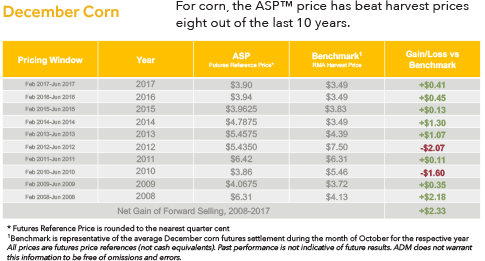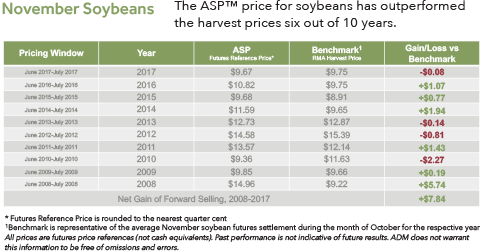Prepare for Typically Better Market Months
It’s hard to believe another harvest is nearly in the books, Thanksgiving’s upon us, and winter is around the corner. If you aren’t already, you’ll soon be planning inputs for your 2018 crop. In this farm economy, spending can be stressful. A few forward marketing moves now can reduce the anxiety of new-crop expenses as you try to relax some over the winter.
One of the easier choices is an Average Seasonal Price (ASP™) contract. To understand why, we talked with Jason Depenbrock, an ADM Grain Origination Manager who works with producers near Mendota, Illinois to help manage their farm price risk.
Jason, how does Average Seasonal Price work?
J: For corn, you enroll a portion of your 2018 corn bushels by January 26 and choose the futures reference month you want to set—September or December of 2018, or March of 2019. Then, from February 5 through July 5, an equal portion of your corn is priced on a daily basis. At the end, you get the market’s average futures price over that period. You still set your own basis—with help from your ADM rep, if you like. ASP for soybeans works the same way, except enrollment ends May 18, the futures reference month is November of 2018, and your soybeans are priced from May 29 through August 2 of 2018.*
What’s the advantage of ASP for a grain marketing plan?
J: If you look through history, you’ll see that time period—February through the beginning of July—is a historically better season in the corn market. Charts show that the fourth of July is a pivotal point in the year, and beyond that, corn markets tend to drop off.
Shouldn’t I try to get a better-than-average price?
J: Remember, you get the average price of a typically better season. Everybody likes to think they can hit the annual market high and avoid the low. But when you look backward through your marketing year, you don’t know what the high has been until it’s over. So it’s prudent to forward-market grain during a typically better season—and get a solid base futures level established for a portion of your anticipated production.
How likely is ASP to capture a better price than I can get at harvest?
J: If you go back 10 years, you’ll see this contract outperforms later markets in the year a majority of the time. For corn, that’s happened eight of the last 10 years; for soybeans, roughly six out of 10. (See illustration.) None of us know when the highs are going to happen, but the average pricing windows that we’ve chosen are a winner over later prices, more often than not. (See chart.)


Can ASP help market my 2017 stored bushels?
J: ASP is set up to forward market your new crop. But if you like the concept, you can enroll stored bushels in a Price Daily contract. This contract is similar to ASP, but you establish your own pricing window.
If I’m not sure of soybeans vs. corn acreage next year, how can I enroll in ASP?
J: You might not know exactly what acres you’re going to plant—whether it’s 50-50, more heavy corn to beans, or more heavy beans to corn. But you know every year that you’re going to put in a minimum. Enroll a portion of that minimum in ASP, then diversify the rest once your plans take shape. It’s a good way to begin your marketing year – and if you wish, you can price out the remaining unpriced quantity any time prior to completion of the pricing window.
Farming prospects can be discouraging. How can forward marketing help?
J: You’re already seeing input costs for next year. Maybe you’re getting seed and fertilizer orders done, and your cash rent is already established. If you want to offset some of those expenses, it’s a good idea to establish a price benchmark. Once spring comes, you’ll be busy planting and watching the market will be even harder. With ASP, you’ll have bushels in the market automatically earning some of the typically better prices of the year. Forward marketing around your break-even number puts you in control.
Tip: Crunching some numbers this winter? Make life easier with a free farm planning and risk management tool called GrainBridge.
What’s the best use of my time during these upcoming winter months?
J: Manage your risks. I don’t think it’s ever too early to start marketing your next year’s crop—or even two years out to get a benchmark established. Ask yourself: How much better off would you be now if you had forward marketed your 2017 bushels for the spring price last year?
To enroll in ADM Average Seasonal Price, contact your local ADM representative by January 26. A Happy Thanksgiving to you and your family. Enjoy some relaxing months as you plan for 2018!
* Subject to Terms and Conditions in ADM-provided contract. Please see contract for details.
